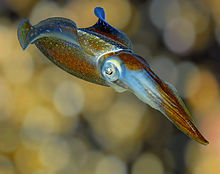Caribbean reef squid
| Caribbean reef squid | |
|---|---|
 |
|
| Scientific classification | |
| Kingdom: | Animalia |
| Phylum: | Mollusca |
| Class: | Cephalopoda |
| Order: | Teuthida |
| Family: | Loliginidae |
| Genus: | Sepioteuthis |
| Species: | S. sepioidea |
| Binomial name | |
|
Sepioteuthis sepioidea (Blainville, 1823) |
|
| Synonyms | |
|
|
Caribbean reef squid (Sepioteuthis sepioidea), commonly called reef squid, are small 20 cm (7.9 in) torpedo-shaped squid with undulating fins that extend nearly the entire length of the body. In 2001, marine biologist Silvia Maciá discovered that squid were able to propel themselves up out of the water about 2 m (6.6 ft) and fly approximately 10 m (33 ft) before re-entry; a discovery which led to the identification of six species of flying squid.
The Caribbean reef squid is found throughout the Caribbean Sea as well as off the coast of Florida, commonly in small schools of 4-30 in the shallows associated with reefs. The habitat of the Reef Squid changes according to the squid's stage of life and size. New hatchlings tend to reside close to the shore in areas from 0.2–1 meters below the surface on or under vegetation. Young small squid typically congregate in shallow turtle grass near islands and remain several centimeters to two meters from the surface to avoid bird predators. Adults venture out into open water and can be found in depths up to 100 m. When mating, adults are found near coral reefs in depths of 1.5–8 m. The Caribbean reef squid is the only squid species commonly sighted by divers over inshore reefs in the Florida, Bahamas and Caribbean region.
This species, like most squid, is a voracious eater and typically consumes 30-60% of its body weight daily. Prey is caught using the club-like end of the long tentacles which are then pulled towards the mouth supported by the shorter arms. Like other cephalopods, it has a strong beak which it uses to cut the prey into parts so that the raspy tongue, or radula, can be used to further process the food. It consumes small fish, other molluscs, and crustaceans.
Caribbean reef squid have been shown to communicate using a variety of color, shape, and texture changes. Squid are capable of rapid changes in skin color and pattern through nervous control of chromatophores. In addition to camouflage and appearing larger in the face of a threat, squids use color, patterns, and flashing to communicate with one another in various courtship rituals. Caribbean reef squid can send one message via color patterns to a squid on their right, while they send another message to a squid on their left.
...
Wikipedia
